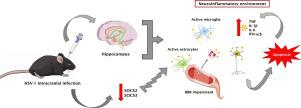Neuroscience Letters ( IF 2.5 ) Pub Date : 2020-08-13 , DOI: 10.1016/j.neulet.2020.135295 Eliana Cristina de Brito Toscano 1 , Larissa Fonseca da Cunha Sousa 2 , Graciela Kunrath Lima 2 , Leonardo Antunes Mesquita 3 , Márcia Carvalho Vilela 4 , David Henrique Rodrigues 4 , Rodrigo Novaes Ferreira 2 , Frederico Marianetti Soriani 5 , Marco Antônio Campos 6 , Erna Geessien Kroon 3 , Mauro Martins Teixeira 7 , Aline Silva de Miranda 2 , Milene Alvarenga Rachid 1 , Antônio Lúcio Teixeira 8

|
Herpes simplex virus type 1 (HSV-1) is the main etiological agent of acute and sporadic encephalitis. Proteins of the suppressor of cytokine signaling (SOCS) family have shown to regulate the inflammation during HSV-1 infection in the brain. However, the effects of SOCS2 and SOCS3 in viral encephalitis remain unclear. The aim of the current study is to investigate the potential association between SOCS2, SOCS3, cytokines, and hippocampal damage, especially neuronal apoptosis, during acute intracranial HSV-1 infection in mice. Male C57BL/6 mice were infected by intracranial route with 102 plaque-forming units (PFU) inoculum of purified HSV-1. At three days post-infection (3 d.p.i.), mice were euthanized and their hippocampi were collected for histopathological analysis, immunohistochemical reaction against active caspase-3 and quantification of SOCS2, SOCS3 and cytokines (tumoral necrosis factor (TNF), interleukin (IL) 1β, IL-6, IL-10; interferon (IFN) -α, IFN-β, IFN-γ) mRNA expression. Infected mice exhibited neuronal loss and hemorrhagic focus in Cornu Ammonis (CA) region. The apoptotic index was higher in infected mice compared to controls. HSV-1 infection was associated with increased hippocampal expression of TNF, IL1-β, IL-6 and IFNα/IFNβ and decreased expression of IL-10, IFN-γ, SOCS2 and SOCS3. Our results suggest that down regulation of SOCS2 and SOCS3 contributes to a pro-inflammatory environment associated with hippocampal damage and neuronal apoptosis during acute HSV-1 infection in mice.
中文翻译:

神经炎症与颅内HSV-1感染过程中SOCS2和SOCS3表达减少有关。
1型单纯疱疹病毒(HSV-1)是急性和散发性脑炎的主要病因。细胞因子信号转导抑制因子(SOCS)家族的蛋白质已显示出可调节大脑HSV-1感染过程中的炎症。但是,尚不清楚SOCS2和SOCS3在病毒性脑炎中的作用。本研究的目的是研究小鼠急性颅内HSV-1感染期间SOCS2,SOCS3,细胞因子与海马损伤,尤其是神经元凋亡之间的潜在关联。雄性C57BL / 6小鼠经颅内途径感染10 2纯化的HSV-1的菌斑形成单位(PFU)接种物。感染后三天(3 dpi),对小鼠实施安乐死,并收集海马进行组织病理学分析,针对活性caspase-3的免疫组织化学反应,并对SOCS2,SOCS3和细胞因子(肿瘤坏死因子(TNF),白介素(IL))进行定量1β,IL-6,IL-10;干扰素(IFN)-α,IFN-β,IFN-γ)mRNA表达。受感染的小鼠在Cornu Ammonis(CA)地区表现出神经元丢失和出血灶。与对照组相比,感染小鼠的细胞凋亡指数更高。HSV-1感染与海马TNF,IL1-β,IL-6和IFNα/IFNβ的表达增加以及IL-10,IFN-γ,SOCS2和SOCS3的表达降低有关。











































 京公网安备 11010802027423号
京公网安备 11010802027423号